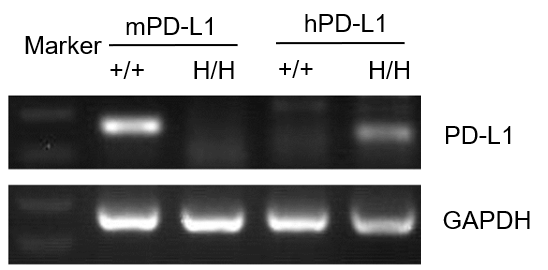Basic Information
-
Targeting Strategy

-

Gene targeting strategy for B-hPD-L1 mice. The exon 3 of mouse Pdl1 gene that encode the extracellular domain was replaced by human PD-L1 exon 3 in B-hPD-L1 mice.
-
Details

-
Phenotype
mRNA expression analysis

Strain specific analysis of PD-L1 gene expression in WT and B-hPD-L1 mice by RT-PCR. Mouse Pdl1 mRNA was only detectable in splenocytes of wild-type (+/+) mice. Human PD-L1 mRNA was only detectable in H/H but not in +/+ mice.
Protein Expression Analysis

Strain specific PD-L1 expression analysis in homozygous B-hPD-L1 mice by flow cytometry.
Splenocytes were collected from WT and homozygous B-hPD-L1 (H/H) mice stimulated with anti-CD3ε in vivo and analyzed by flow cytometry with species-specific anti-PD-L1 antibody. Mouse PD-L1 was only detectable in WT mice. Human PD-L1 was exclusively detectable in homozygous B-hPD-L1 but not in WT mice.
Application
In vivo efficacy of anti-human PD-L1 antibody

Antitumor activity of anti-human PD-L1 antibody in B-hPD-L1 mice.
(A) Anti human PD-L1 antibody inhibited MC38-hPD-L1 tumor growth in B-hPD-L1 mice. Murine colon cancer MC38-hPD-L1 cells (5×105) were subcutaneously implanted into homozygous B-hPD-L1 mice (female, 6-week-old, n=5). Mice were grouped when tumor volume reached approximately 100 mm3, at which time they were treated with anti-human PD-L1 antibody with doses and schedules indicated in panel. (B) Body weight changes during treatment. As shown in panel A, anti-human PD-L1 antibody was efficacious in controlling tumor growth in B-hPD-L1 mice, demonstrating that the B-hPD-L1 mice provide a powerful preclinical model for in vivo evaluation of anti-human PD-L1 antibodies. Values are expressed as mean ± SEM.

Antitumor activity of anti-human PD-L1 antibody in B-hPD-L1 mice.
(A) Anti-human PD-L1 antibody inhibited MC38-hPD-L1 tumor growth in B-hPD-L1 mice. Murine colon cancer MC38-hPD-L1 cells (5×105) were subcutaneously implanted into homozygous B-hPD-L1 mice (n=8). Mice were grouped when tumor volume reached approximately 100 mm3, at which time they were treated with anti-human PD-L1 antibody with doses and schedules indicated in panel A. (B) Body weight changes during treatment. As shown in panel A, anti-human PD-L1 antibody was efficacious in controlling tumor growth in B-hPD-L1 mice, demonstrating that the B-hPD-L1 mice provide a powerful preclinical model for in vivo evaluation of anti-human PD-L1 antibodies. Values are expressed as mean ± SEM.

Antitumor activity of anti-human PD-L1 antibody in B-hPD-L1 mice.
(A) Anti human PD-L1 antibody avelumab (in house) inhibited MC38-hPD-L1 tumor growth in B-hPD-L1 mice. Murine colon cancer MC38-hPD-L1 cells (5×105) were subcutaneously implanted into homozygous B-hPD-L1 mice (female, 6-week-old, n=5). Mice were grouped when tumor volume reached approximately 100 mm3, at which time they were treated with anti-human PD-L1 antibody with doses and schedules indicated in panel. (B) Body weight changes during treatment. As shown in panel A, different doses of human PD-L1 antibody avelumab (in house) inhibited tumor growth in different levels, demonstrating that the B-hPD-L1 mice provide a powerful preclinical model for in vivo evaluation of anti-human PD-L1 antibodies. Values are expressed as mean ± SEM.

Antitumor activity of anti-human PD-L1 antibody in B-hPD-L1 mice.
(A) Anti-human PD-L1 antibody durvalumab (in house) inhibited MC38-hPD-L1 tumor growth in B-hPD-L1 mice. Murine colon cancer MC38-hPD-L1 cells (5×105) were subcutaneously implanted into homozygous B-hPD-L1 mice (female, 6-week-old, n=5). Mice were grouped when tumor volume reached approximately 150±50 mm3, at which time they were treated with anti-human PD-L1 antibody with doses and schedules indicated in panel. (B) Body weight changes during treatment. As shown in panel A, different doses of human PD-L1 antibody durvalumab (in house) inhibited tumor growth in different levels, demonstrating that the B-hPD-L1 mice provide a powerful preclinical model for in vivo evaluation of anti-human PD-L1 antibodies. Values are expressed as mean ± SEM.
Anti-human PD-L1 antibodies bind to MC38 and MC38-hPD-L1 cells

Anti-hPD-L1 antibodies bind to MC38 and MC38-hPD-L1 cells
MC38 and MC38-hPD-L1 cells were collected and incubated with different antibodies. Flow cytometry analysis showed that atezolizumab and avelumab bind to MC38 cells,while durvalumab can not bind to MC38 cells. Atezolizumab, avelumab and durvalumab can bind to MC38-hPD-L1 cells. *The antibodies were synthesized in house.
-
Publications using B-hPD-L1 mice

-
References

-
1. Trends Mol Med. 2015 Jan;21(1):24-33. doi: 10.1016/j.molmed.2014.10.009. Epub 2014 Oct 30.
2. Proc Natl Acad Sci U S A. 2008 Feb 26;105(8):3011-6. doi: 10.1073/pnas.0712278105. Epub 2008 Feb 14.
3. Int Immunol. 2007 Jul;19(7):881-90. Epub 2007 Jul 2.


